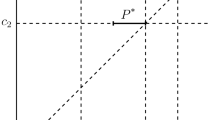Abstract
The theory presented in this paper investigates the connection between the number of competitors and the tendency to cooperate within the context of a symmetric Cournot model with linear cost and demand, supplemented by specific institutional assumptions about the possibilities of cooperation. Cooperative forms of behavior are modelled as moves in a non-cooperative game. The proposition that few suppliers will maximize their joint profits whereas many suppliers are likely to behave non-cooperatively does not appear as an assumption but as a conclusion of the theory. For the simple model analyzed in this paper a definite answer can be given to the question where a “small group” of competitors ends and a “large group” begins: 5 is the dividing line between “few” and “many”.
Similar content being viewed by others
References
Aumann, J.: Mixed and Behavior Strategies in Infinite Extensive Games. In: M.Dresher, L. S.Shapley, and A. W.Tucker (eds.): Advances in Game Theory, Annals of Mathematics Studies52, 627–650, 1964, Princeton.
Chamberlin, E. H.: The Theory of Monopolistic Competition, Cambridge. Mass. 1933.
Cournot, A.: Recherches sur les principes mathématiques de la théorie des richesses. Paris 1938.
Harsanyi, J. C., andR. Selten: A Solution Concept Unifying the Theories of Cooperative and Non-Cooperative Games (abstract), Econometrica39, 96–97, 1971.
Kuhn, H. W.: Extensive Games and the Problem of Information. In: H. W.Kuhn and A. W.Tucker (eds.): Contribution to the Theory of Games, Vol. II, Annals of Mathematics Studies28, 193–216, 1953, Princeton.
Luce, D. R., and H.Raiffa: Games and Decisions. New York-London-Sidney 1957.
Nash, J. F.: Non-cooperative Games, Annals of Mathematics54, 155–162, 1951.
Neumann, J.v., and O.Morgenstern: Theory of Games and Economic Behavior. Princeton 1944.
Schelling, Th. C.: The Strategy of Conflict, Cambridge, Mass. 1960.
Selten, R.: Spieltheoretische Behandlung eines Oligopolmodells mit Nachfrageträgheit. Zeitschrift für die gesamte Staatswissenschaft121, 301–324, 667–689, 1965.
—: An Oligopoly Model with Demand Inertia. Working paper 250, Center for Research in Management Science, University of California, Berkeley 1968.
—: Preispolitik der Mehrproduktenunternehmung in der statischen Theorie. Berlin-Heidelberg, New York 1970.
Stevens, C. M.: Strategy and Collective Bargaining Negotiations. New York 1963.
Author information
Authors and Affiliations
Rights and permissions
About this article
Cite this article
Selten, R. A simple model of imperfect competition, where 4 are few and 6 are many. Int J Game Theory 2, 141–201 (1973). https://doi.org/10.1007/BF01737566
Received:
Issue Date:
DOI: https://doi.org/10.1007/BF01737566



